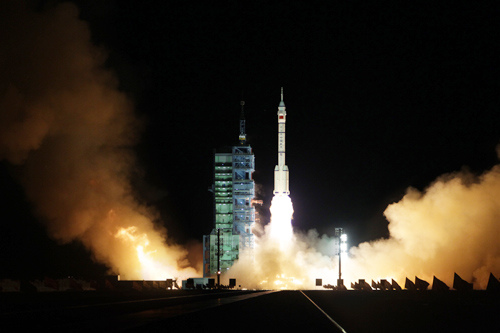|
 |
|
GOING INTO SPACE: A modified model of the Long March-2F rocket carrying the unmanned spacecraft Shenzhou 8 blasts off from the launch pad at the Jiuquan Satellite Launch Center (WANG XIANG) |
"The automated control system and docking system were crucial to the mission, and simulations had been performed several times on the ground," according to Wu.
Meanwhile, Chinese space engineers made "considerable modifications" to the Shenzhou 8, making it significantly different from previous versions of China's unmanned spacecraft.
Shenzhou 8, with a length of 9 meters and a maximum diameter of 2.8 meters, has a liftoff weight of 8.082 tons.
"More than half of the spacecraft's 600 or so sets of equipment had been modified technically, while newly designed devices account for about 15 percent of the total," Wu said.
"The system for voice transmission between the spacecraft and the ground on this mission was completely new and significantly more advanced than the one used in Shenzhou 7," said Sun Yadu, chief engineer with Beijing Special Engineering Design and Research Institute, the main designer of the launch system used at the Jiuquan Satellite Launch Center.
"The modifications were mainly intended to equip the spacecraft with automatic and manual rendezvous and docking capacities, and to enhance the vehicle's performance, safety and reliability," Wu said.
"After the improvements, the spacecraft will be able to stay attached to the target spacecraft, Tiangong-1, for 180 days," Wu said.
It's not just the technology on board the Shenzhou 8 that ensured the mission's success, the timing and precision of the spacecraft's launch was crucial. The satellite had to enter the same orbital plane as Tiangong-1.
"Tiangong-1's orbital plane intersects with the launch site, we launched Shenzhou 8 at the 'zero launch window,'" said Wu, referring to the precisely prescribed launch time.
Technological modifications were also made to the carrier. "The rocket features a new control system and an improved thruster, which means the Long March-2FY8 can carry a larger payload, features higher orbital precision and is more reliable than previous rockets," Wu said.
The 58.3-meter-long Long March-2FY8 rocket has a total lift off weight of 497 tons and can carry a payload of 8,130 kg.
Meanwhile, the target vessel, Tiangong-1, had also been fully prepared for the upcoming docking.
On October 30, the Tiangong-1 completed a 180-degree turn-around under the control of the Beijing Aerospace Flight Control Center. The space module was then lowered to the 343-km-high docking orbit through a series of maneuvers which took place over the course of a month.
A historic meeting
Before the docking, Tiangong-1 made five orbital changes and four "brakes" over a 1.3-million-km journey.
After the maneuvers, Shenzhou 8 entered an orbit below Tiangong-1, which circles 343 km above the Earth's surface.
When the distance between the two craft narrowed to 52 km, sensors on Shenzhou 8 took over from ground control and safely guided Shenzhou 8's approach to Tiangong-1. Once the aircraft were in relatively close proximity it took two and a half hours of maneuvers to take the craft to within centimeters of the Tiangong-1.
| 